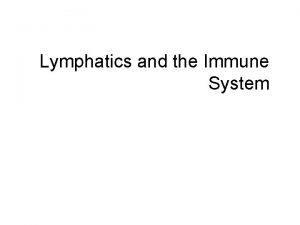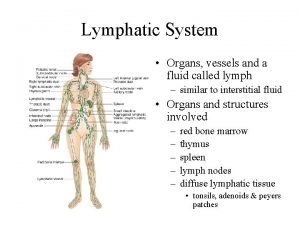Immune System and Lymphatic tissue Organs in the







- Slides: 7

Immune System and Lymphatic tissue

Organs in the immune system § Bone marrow § Thymus § Spleen § Lymph nodes § Peyer

Thymus § Unlike most other lymphoid structures, the thymus grows rapidly and attains its greatest size relative to the rest of the body during fetal life and the first years after birth. § Thereafter, it continues to grow, but more slowly than the other organs. At the onset of puberty, the thymus begins a slow process of shrinking. This gradual diminution in size continues for the rest of the individual’s life.

Lymphoid tissue § Lymphoid tissue in the human body is associated with the mucosal system. § Mucosa-associated lymphoid tissue (MALT) is scattered along mucosal linings and protects the body from antigens entering along mucosal surfaces. § MALT includes: § gut-associated lymphoid tissue (GALT) § nose-associated lymphoid tissue (NALT) § bronchial/tracheal-associated lymphoid tissue (BALT)

What is MALT § MALT is an acronym for mucosa-associated lymphatic tissue. It includes Peyer's patches, the appendix, and the tonsils in the digestive tract, lymphoid follicles in the walls of the bronchi, and genitourinary tract. § Collectively, MALT protects passages open to the exterior from foreign matter entering them § MALT is one of the major secondary lymphoid organs, along with the lymph nodes and spleen. § It is distributed on a mucosal surface of 400 m 2 and, considering the enormous quantity and variety of antigens coming into contact with these mucosae, plays an important immunological role.

What is lymph? § The remaining 10% of the fluid that stays behind in the tissues as a clear to yellowish fluid known as lymph. § Unlike blood, which flows throughout the body in a continue loop, lymph flows in only one direction within its own system. This flow is only upward toward the neck. Here, it flows into the venous blood stream through the subclavien veins which are located on either sides of the neck near the collarbones. § After plasma has delivered its nutrients and removed debris, it leaves the cells. 90% of this fluid returns to the venous circulation through the venules and continues as venous blood. § The remaining 10% of this fluid becomes lymph which is a watery fluid that contains waste products. This waste is protein-rich due to the undigested proteins that were removed from the cells.

Lymphatic circulation § Lymph circulates to the lymph node via afferent lymphatic vessels and drains into the node just beneath the capsule in a space called the subcapsular sinus. § The subcapsular sinus drains into trabecular sinuses and finally into medullary sinuses. § The sinus space is criss-crossed by the pseudopods of macrophages, which act to trap foreign particles and filter the lymph. The medullary sinuses converge at the hilum and lymph then leaves the lymph node via the efferent lymphatic vessel towards either a more central lymph node or ultimately for drainage into a central venous subclavian blood vessel, most via the postcapillary venules, and cross its wall by the process of diapedesis.













